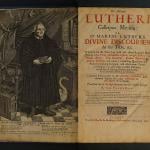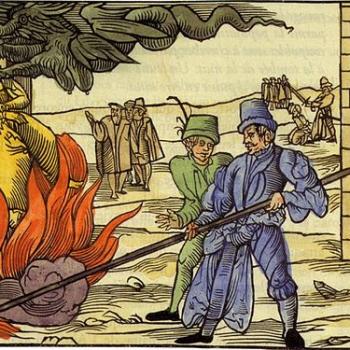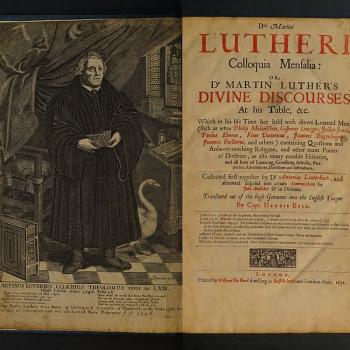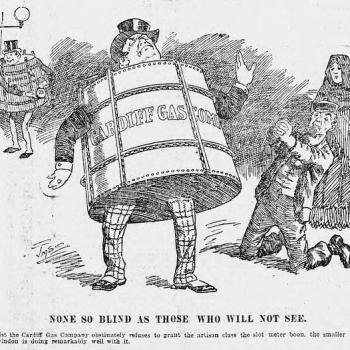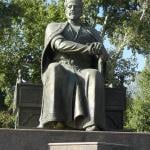Including Two Examples of Luther’s Espousal of Capital Punishment for Wrong or Aberrant Behavior Prior to 1530
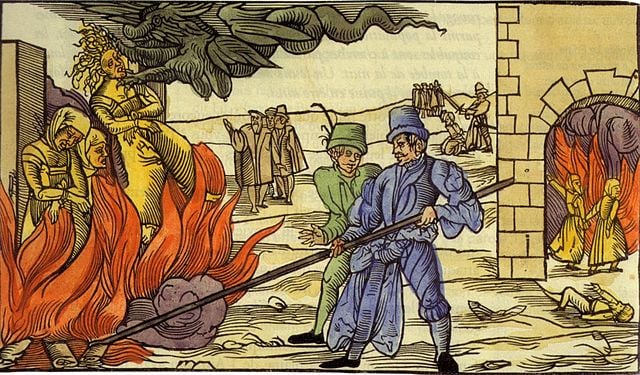
It’s commonly thought by students of 16th-century Christianity (who have an adequate knowledge of the historical facts) that Martin Luther advocated tolerance towards belief-systems and behaviors contrary to what he thought was Christian, and prior to 1530 (i.e., in the first twelve years or so of his proclaimed “reformation”); thus was opposed to persecution up to and including execution on these grounds.
Many other Protestants are under the illusion that Luther was always tolerant and never advocated persecution for religious beliefs different than his own. I’ve talked to, for example, at least one wife of a Lutheran pastor who thought this. The myth of the tolerant Luther dies hard in many folks. One can only present the documented facts. You can lead a horse to water but you can’t make it drink. I’ve written about it several times:
Luther Favored Death Penalty for Anabaptists [2-24-04]
Luther’s Attitudes on Religious Liberty (Roland H. Bainton) [2-16-06]
Luther on the Deaths of Zwingli, St. Thomas More, & St. John Fisher [11-30-07; expanded on 10-31-17]
Luther Favored Death, Not Religious Freedom, For ‘Heretics’ [National Catholic Register, 10-25-17]
Protestants Executed Peaceful Anabaptists (vs. L. Banzoli) [6-20-22]
James Swan Rationalizes Luther’s Intolerance Again [11-22-24]
I’d like to specifically discuss in this article “early” and “weird” examples of Luther’s views in this regard. As early as 1522, he had written:
[p. 32] You may ask: What is to become of the other [the guilty party] if he too is perhaps unable to lead a chaste life? Answer: It was for this reason that God commanded in the law [Deut. 22:22-24] that adulterers be stoned, that they might not have to face this question. The temporal sword and government should therefore still put adulterers to death. . . . Where the government is negligent and lax, however, and fails to inflict the death penalty, the adulterer may betake himself to a far country and there remarry if he is unable to remain continent. But it would be better to put him to death, lest a bad example be set . . .
The blame rests with the government. [p. 33] Why do they not put adulterers to death? Then I would not need to give such advice. Between two evils one is always the lesser, in this case allowing the adulterer to remarry in a distant land in order to avoid fornication. . . .
Where the government fails to inflict the death penalty and the one spouse wishes to retain the other, the guilty one should still in Christian fashion be publicly rebuked and caused to make amends according to the gospel . . .
[p. 34] Here you should be guided by the words of St. Paul, I Corinthians 7 [:4–5], “The husband does not rule over his own body, but the wife does; likewise the wife does not rule over her own body, but the husband does. Do not deprive each other, except by agreement,” etc. Notice that St. Paul forbids either party to deprive the other, for by the marriage vow each submits his body to the other in conjugal duty. When one resists the other and refuses the conjugal duty she is robbing the other of the body she had bestowed upon him. This is really contrary to marriage, and dissolves the marriage. For this reason the civil government must compel the wife, or put her to death. If the government fails to act, the husband must reason that his wife has been stolen away and slain by robbers; he must seek another. We would certainly have to accept it if someone’s life were taken from him. Why then should we not also accept it if a wife steals herself away from her husband, or is stolen away by others? (The Estate of Marriage, 1522, translated by Walther I. Brandt, from Luther’s Works, Vol. 45, pp. 32-34)
This is marvelous reform of the morals concerning sexuality that the Catholic Church had cultivated for 1500 years, isn’t it? The state puts adulterers to death. Frigid women should also be done away with by the state. If the state doesn’t execute adulterers, they ought to run away to another country and get remarried (!!!).
Luther doesn’t say whether an impotent man should likewise be put away by the wife or put to death by authorities (the “ED police”?). I suspect he would not take such a position. No, only women who aren’t fulfilling their sexual duties (men always do, no doubt) are subjected to such drastic measures, and the adulterous man can flee to another country, where Luther in his wisdom recommends another “marriage” as the “lesser” of “two evils.” We can see how the “Reformation” truly liberated women from Catholic chauvinistic medieval serfdom, can’t we?
Self-proclaimed expert on Luther and Reformed Protestant apologist and polemicist James Swan, aka Tertiumquid (see his lengthy section on my Anti-Catholicism page). blissfully unaware of the above, nevertheless makes one of his sweeping and historically ignorant whoppers in a comment on the anti-Catholic CARM forum, on 2-11-25:
Linking Luther to intolerance and capital punishment in 1523 does not comport with Luther scholarship. At this period in his career, it’s highly unlikely he advocated executing heretics. (comment #96 in the thread, “Is burning heretics against the will of the Holy Spirit?”: p. 5)
With more nuance, Swan wrote on his blog, Boors All, on 8-13-15:
Luther did support a broader concept of religious freedom previous to 1530. He then saw public blasphemy and sedition as two offenses that should be reprimanded. The death penalty may be invoked in certain instances.
In 1526, Luther preached that female sorcerers should be put to death (not sure if he thought the same about male sorcerers):
Concerning the female sorcerer. . . . Why does the law name women more than men here, even though men are also guilty of this? Because women are more susceptible to those superstitions of Satan; take Eve, for example. They are commonly called “wise women.” Let them be killed. (Sermon on Exodus 22:18: “You shall not permit a female sorcerer to live,” 1526, WA [Weimar collection of Luther’s writings] XVI, p. 551; in Susan C. Karant-Nunn & Merry E. Wiesner-Hanks [editors and translators], Luther on Women: a Sourcebook, Cambridge University Press, 2003, p. 231)
In 1538, Luther advocated the burning of witches:
On that day (August 20, 1538), [Georg] Spalatin [good friend of Luther’s] related the tale of a witch’s insolence, and how a girl at Altenburg shed tears of blood whenever the woman was present, for, even if she did not see her nor know of her, yet she felt her presence and shed tears. Luther answered: “One should hasten to put such witches to death. The jurists wish to have too many witnesses, despising these plain signs. Recently I had to deal with a matrimonial case, where the wife wished to poison her husband, so that he vomited lizards. When she was examined by torture she answered nothing, because such witches are dumb; they despise punishment and the devil does not let them speak. These facts show plainly enough that an example should be made of them to terrify others.”
On August 25 (1538), they spoke much of witches who stole eggs from hens and milk and butter. Luther said: “No mercy is to be shown them. I myself would begin to burn them according to the law that the priests should begin to stone culprits.” (Conversations With Luther: Selections from Recently Published Sources of the Table Talk, translated and edited by Preserved Smith and Herbert Percival Gallinger, New York: The Pilgrim Press, 1915, pp. 163-164)
Smith and Gallinger commented in a footnote to this on page 164:
Such sayings as these fanned the flames of the horrible persecution of witches by which hundreds of thousands of harmless persons lost their lives in the sixteenth century. Four witches were executed at Wittenberg in 1540.
This is a trustworthy portion of the Table Talk, according to the scholarly criteria which I presented at some length in my article, “Luther’s ‘Table Talk’: How Historically Accurate Is It?” (4-7-25). Preserved Smith (1880-1941) was an American historian of the Protestant “Reformation”: whose doctoral dissertation at Columbia University (1907) was a critical study of the Table Talk. Since he included the above excerpts in his book, he deemed them to be “original records” which “in recent years has for the first time offered a really good text . . . new material of first importance” (Conversations . . . Introduction, pp. xxv-xxvi)
Alas, the editors of Luther’s Works (55 volumes in English) chose not to include this entry (perhaps readers can guess why). The entirety of Volume 54 (published in 1967: 52 years after Smith’s book) is devoted to a chronological compilation of Luther’s recorded utterances in the Table Talk (as best as can be determined). But it includes entries from August 19th and 22nd, 1538 (pp. 300-304) and on August 25th, but on a different topic (p. 305).
Luther lived in Wittenberg and died there in 1546. So it’s quite possible if not plausible that he approved of these particular burnings. An article from the website Alaturka.info entitled, “Martin Luther – Reformation movement and witch burning” (7-29-18) commented on seemingly the same incident. I don’t know how accurate it is, but for what it’s worth:
Prista Frühbottin was arrested by the electoral bailiff, because she was accused of having poisoned the cattle in the pasture with the help of her son and two farmhands. In truth, a drought had killed the cattle. However, after the trial and torture, the defendants were tied to oak piles in the marketplace on June 29, 1540, and were burned alive by the fire below them.
The artist and eyewitness, Lucas Cranach the Younger, made a woodcut of the pyre [see a photo of it]. The Wittenberg executioner Magnus Fischer was also suspected of having been in close contact with Prista Frühbottin. He as well was seized and sentenced to death by burning, executed in Eisleben on July 7, 1540. In Wittenberg at least 21 people from 1540 to 1674 were affected by witch-hunts: eight executions [were] witnessed, of 13 other procedures the output is not known. In connection with the trial of Prista Frühbottin, it is said in the documents handed down that many others have been arrested and convicted.
In another Table Talk excerpt from the period 1538-1540, drawn from the Weimar edition, deemed to be quite trustworthy by the editors of Luther’s Works (Vol. 54, Introduction), Luther advocated the torturing (and execution?) of witches, thus echoing the worst excesses and sins of Catholic inquisitorial tactics which are endlessly decried by Protestant apologists and polemicists (even actual historians), with the constant implication that Luther and Protestants supposedly rose above all that.
I agree with the condemnations of such practices (unlike Luther, I have never advocated them for heresies and false beliefs, and am also opposed to capital punishment, period), but disagree with the Massive Lie that only Catholics believed and engaged in them in past eras. Luther stated (i.e., was recorded to have stated):
Out of special hatred for our faith, the devil has sent some whores here to destroy our poor young men . . . such a syphilitic whore can poison ten, twenty, thirty or more of the children of good people, and thus is to be considered a murderer, or worse, as a poisoner. . . .
And I must speak plainly. If I were a judge, I would have such a poisonous, syphilitic whore tortured by being broken on the wheel and having her veins lacerated, for it is not to be denied what damage such a filthy whore does to young blood, so that it is unspeakably damaged before it is even fully grown and destroyed in the blood. (Table-Talk, WA, TR, IV, no. 4857, pp. 552-554; cited in Susan C. Karant-Nunn & Merry E. Wiesner-Hanks, ibid., pp. 157-158)
Luther’s Works again chose to omit this entry, even though it is from impeccable sources, according to its own discussion of Table Talk in the Introduction to Volume 54. The chronological listing of excepts originally numbered in the Weimar German edition jumps from #4716 (p. 363) to #4875 (p. 369). One must really “dig” to find Luther statements like these.
But they may be available in Luther’s Works in due course, because it’s being expanded from the initial 55 volumes, with many more volumes to be added. So far, 82 volumes have been published or planned, but looking over their titles, I see no “Table Talk Part II” among them. So unless one knows German, “shocking” and “inquisitorial”-like statements like the one above have to be found in articles such as this one, or the books from which I draw them.
They’re not likely to ever be heard from Lutheran or other Protestant pulpits on Sunday: that‘s for sure!
Related Reading
Protestantism: Historic Persecution & Intolerance (my web page)
*
***
*
Photo credit: witches being burned in Nuremburg (from 1525 a Protestant town) in 1555 [public domain / Wikimedia Commons]
Summary: I document that Luther advocated execution for adulterers & frigid wives in 1522, for sorcerers in 1526, burning of witches in 1538, & torturing prostitutes in 1538-1540.


